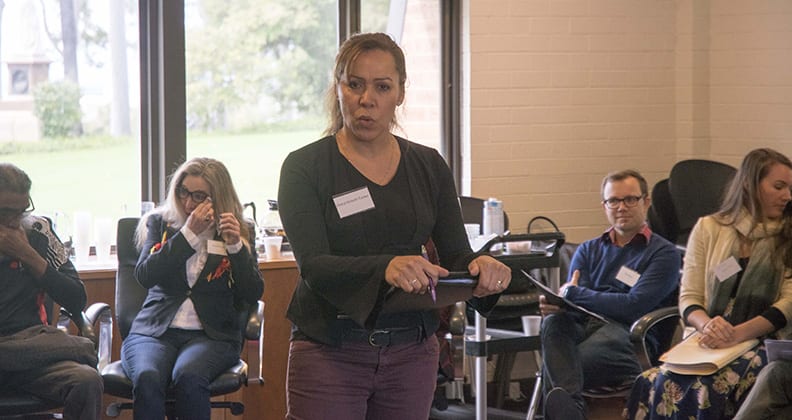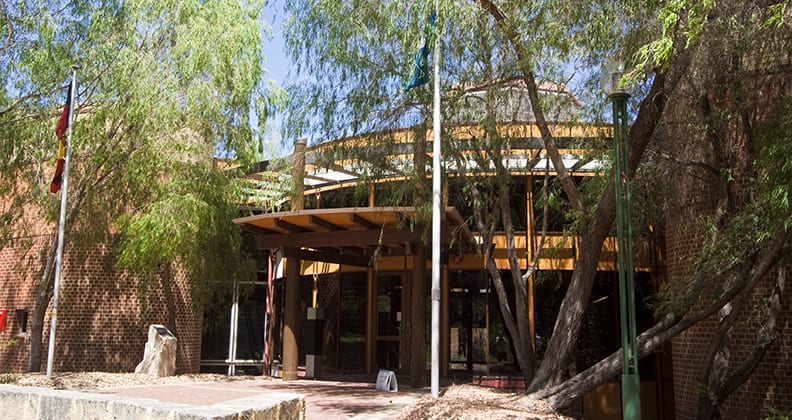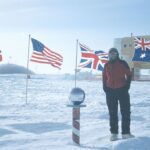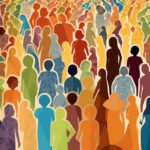An Acknowledgement of Country precedes many formal and informal occasions in Australia, and is an opportunity to show respect for Traditional Owners and the ongoing and rich connection Indigenous Australians have to Country.
Outside such occasions, though, there is little effort to understand what this connection really means and how a stronger, true recognition of First Nations people is crucial for justice and our collective futures.
This issue was at the heart of Decolonising Settler Cities: a 2017 symposium that brought Indigenous non-Indigenous Australians together to discuss ways to reconstruct and relearn how we navigate modern Australia, which has been founded on western, colonial systems that don’t readily include Indigenous Australians’ knowledges, cultures, laws, rights or practices.
Decolonisation
The event was an act of decolonisation, a conscious effort to prioritise and practise Indigenous culture and values over dominant interests.
It is through decolonisation that Indigenous Australians can recover what Noel Pearson described in a 2014 Quarterly Essay as “identity as a people; the territorial lands of a people; language; and culture.”
Carol Dowling is Badimaya/Yamatji woman from the central west of Western Australia and an Associate Lecturer at Curtin in the Centre for Aboriginal Studies (CAS). Dowling says decolonisation can be a way for non-Indigenous Australians to genuinely acknowledge the trauma inflicted upon Aboriginal and Torres Strait Islander people through colonialism.
“Decolonisation is about repairing damage. We can’t do it alone,” Dowling says. “Non-Indigenous people have to do it with us, because when they learn about this colonial history, they learn not to ever repeat it. And it gets into their consciousness, it gets into their veins, and that’s when we can start to have a proper relationship from then on.”

Indigenist research
One way of achieving decolonisation is through Indigenist research. Dr Karen L Martin, a Noonuccal woman from south east Queensland and researcher in Indigenist and Aboriginal pedagogy, defines Indigenist research as “centering Aboriginal ways of knowing, ways of being, and ways of doing, in alignment with aspects of western qualitative research frameworks.”
Tod Jones is a Senior Lecturer in Geography at Curtin of Anglo-Australian descent and one of the organisers of Decolonising Settler Cities. He says Indigenist research can create a different dialogue.
“The problem with dialogue in the past is that a lot of it has been based on the terms of white researchers, and they really struggle to actually understand Aboriginal perspectives and create a space where Aboriginal knowledge and practice can be articulated in a free and generous manner.”
“We are the most researched people on the planet, and our relationship with research is fraught, because it was used as a tool of colonialism,” Dowling says. “If you’re ever going to conduct research, you have to do it Blackfella way, and that’s what we were trying to say [at the symposium]. Research has to have a different way of looking at things.”
At the symposium, Dowling led a yarning circle, where participants are able to have their say in a safe space without judgement.
“A yarning circle is the way that we construct knowledge in our communities,” Dowling says. “Yarning can be various forms, such as social yarning where you get together and talk about your families and who’s marrying who etc., and then you have more purposeful yarning where you talk about collaboration and gain consensus on how to solve issues.
“The way that a good yarn happens is that you learn to listen; to actually be conscious of the environment you’re in, the people you are with and how you engage with them as individuals … I could sense from the group that a few of the non-Indigenous participants were really appreciative of a different way of doing it, and it was very centering for them.”

The symposium and yarning circle show how we can include Indigenous perspectives in research contexts, which will result in wider, more positive implications in urban Australia.
“We’re only going to move past the current impasse in cities if you can have a proper dialogue, and you’re not going to get it with a standard academic event,” Jones says.
“The only way you’re going to get dialogue is through that kind of centering of Aboriginal people’s experiences, voices and recognition of their knowledge, and giving them the opportunity to express that in forums that are open to it; to allow custodians to be generous with what they know.”
“One of the things we always fight against as Aboriginal researchers and writers, is the silencing of Aboriginal people,” Dowling says, “so having a dynamic such as the yarning circle is the complete polar opposite and we think it’s a fantastic opportunity.”
Reaching the community
Indigenist research is being applied in urban projects throughout Australia. Local examples include Fremantle design group UDLA, whose philosophy is to address urban design approaches by working alongside Indigenous custodians and understanding that people and place need to be connected.
“We are continually evolving a design philosophy that hinges around the understanding that the health of a community has a reciprocal relationship with how empowered participants are engaged with their environment,” says UDLA Principal Director Greg Grabasch in his symposium abstract.
“Working as a non-Indigenous consultant and learning from local people requires constant self-checking and assessment in motives and approach. It also requires developing a background of relationship and trust, including a non-adversarial approach to design and planning.”
Another example of Indigenist research is by Warrick Fort, an entrepreneur and Curtin PhD candidate within the School of Built Environment. Fort is researching how Indigenous Australian ontologies have typically been considered out of place within cities and incompatible with western notions of economic success. However, Warrick says that many Indigenous entrepreneurs living in the Perth metropolitan area are achieving business success while maintaining distinctive connections to kin, culture and Country.
“Many of these entrepreneurs will seek the permission of elders to start a business, and will often ask for their advice and approval when developing new business services,” Fort explains.
“Aboriginal entrepreneurs who provide cultural education services may also ask elders to participate in business activities. Not only is this a way of reaffirming the important role that these elders hold within their community, their involvement improves customer experiences as they can share their personal histories and knowledge of culture and language, and the entrepreneur can also learn and develop their own cultural knowledge.”

Decolonisation at Curtin
Curtin has always been inclusive of Indigenous Australians, says Dowling, and continues to explore how their diverse knowledges and practices can be incorporated and disseminated across the University.
“I get the real gist about Curtin being a place that actually takes pride in researching what it does and asking, ‘Are we doing things right? Is this being innovative? What can we do to really change and look at things from a different perspective?’”
Curtin’s Centre for Aboriginal Studies (CAS) is the driving force behind Curtin’s success in contributing to positive social change, and is a space for Aboriginal people that promotes a sense of belonging, autonomy and strength. CAS has worked in collaboration with the broader University to implement multiple initiatives such as the 2008 Reconciliation Action Plan, a compulsory Indigenous Cultures and Behaviours unit for all Health Sciences students, and programs for staff to develop greater cultural awareness and working relationships with Aboriginal people.
While Dowling says it’s important to recognise the progressive work between CAS and the University, Curtin needs to be continually committed to promoting change.

“The role of universities used to be quite radical; perhaps Curtin may be that role model where we assert the ways things should be done in the rest of society,” she says. “I’d like to see the Health Sciences unit be rolled out across all faculties, for example. We could have a different graduate profile.
“I get it all the time – we’ll have a student who’ll say, ‘how is this unit relevant to what I’m studying? I’ll never engage with an Aboriginal person’, and we say, ‘Yes you will – you see Aboriginal people in society, don’t you? Or you will talk to people who will have an opinion of Blackfellas.’
“We will give you a toolbox that you can draw upon and strengthen throughout your whole life about how to show tolerance, respect and empathy to Aboriginal people.”
Why decolonisation?
Australia is the only Commonwealth country to have never signed a treaty with its Indigenous People. Aboriginals and Torres Strait Islanders are still not formally recognised in the Constitution, and the latest attempt to embed an Indigenous voice to Parliament as drafted in the Uluru statement was rejected by the Turnbull government.
A tendency to talk ‘to’ instead of ‘with’ Indigenous Australians on matters that concern them has created a severe inequality that affects Indigenous people every day.
Their life expectancy is ten years less than non-Indigenous Australians; their children are twice as likely to die as infants and their health, education and employment outcomes are worse than non-Indigenous people. In Western Australia, Aboriginal and Torres Strait Islander children make up 54.5 per cent of those living in out-of-home care.
“We need to maintain our culture and identity as Aboriginal people and we are still doing it under extreme circumstances,” Dowling says.
“Half of the children in out-of-home care in this state are Aboriginal, yet we’re only five per cent of the population. These kids are going to spend their formative years in an institutional setting and are not going to understand the fundamentals of what it means to be First Nations people.”
Going forward
There is an impasse at the federal level for Indigenous sovereignty, but there are pockets of progress occurring in wider society. The recent announcement by the Anangu people to close Uluru to climbers by 2019, as well as the growing push to change the date on which we celebrate Australia Day, exemplify a shift in attitude by many Australians for real reconciliation.
Dowling admits it is tiring to continually be an advocate for change, but she stresses that it’s through decolonisation, places like CAS and events like the symposium that we can pave the way for an Australia that is truly inclusive.
“Decolonisation is like a tapestry; our culture is like a tapestry with big bloody stab holes in it and what we’ve gotta do is repair that. We will probably never get the same thread, but it will be ours and something we can own and use to move forward.”
View the complete list of projects discussed at the Decolonising Settler Cities symposium.



